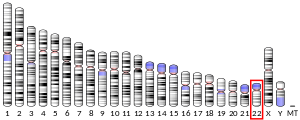From Wikipedia, the free encyclopedia
Protein-coding gene in the species Homo sapiens
TRIO and F-actin-binding protein is a protein that in humans is encoded by the TRIOBP gene .[ 5] [ 6] [ 7] [ 8]
This gene encodes a protein that interacts with Trio, which is involved with neural tissue development and in controlling actin cytoskeleton organization, cell motility , and cell growth . This trio-binding protein also associates with F-actin and stabilizes F-actin structures. Domains contained in this encoded protein are an N-terminal pleckstrin homology domain and a C-terminal coiled-coil region. Mutations in this gene have been associated with a form of autosomal-recessive nonsyndromic deafness . Multiple alternatively-spliced transcript variants that would encode different isoforms have been found for this gene, though some transcripts may be subject to nonsense-mediated decay (NMD).[ 8]
^ a b c GRCh38: Ensembl release 89: ENSG00000100106 – Ensembl , May 2017^ a b c GRCm38: Ensembl release 89: ENSMUSG00000033088 – Ensembl , May 2017^ "Human PubMed Reference:" . National Center for Biotechnology Information, U.S. National Library of Medicine .^ "Mouse PubMed Reference:" . National Center for Biotechnology Information, U.S. National Library of Medicine .^ Seipel K, O'Brien SP, Iannotti E, Medley QG, Streuli M (Jan 2001). "Tara, a novel F-actin binding protein, associates with the Trio guanine nucleotide exchange factor and regulates actin cytoskeletal organization". J Cell Sci . 114 (Pt 2): 389–99. doi :10.1242/jcs.114.2.389 . PMID 11148140 . ^ Riazuddin S, Khan SN, Ahmed ZM, Ghosh M, Caution K, Nazli S, Kabra M, Zafar AU, Chen K, Naz S, Antonellis A, Pavan WJ, Green ED, Wilcox ER, Friedman PL, Morell RJ, Riazuddin S, Friedman TB (Dec 2005). "Mutations in TRIOBP, which encodes a putative cytoskeletal-organizing protein, are associated with nonsyndromic recessive deafness" . Am J Hum Genet . 78 (1): 137–43. doi :10.1086/499164 . PMC 1380211 PMID 16385457 . ^ Shahin H, Walsh T, Sobe T, Abu Sa'ed J, Abu Rayan A, Lynch ED, Lee MK, Avraham KB, King MC, Kanaan M (Dec 2005). "Mutations in a novel isoform of TRIOBP that encodes a filamentous-actin binding protein are responsible for DFNB28 recessive nonsyndromic hearing loss" . Am J Hum Genet . 78 (1): 144–52. doi :10.1086/499495 . PMC 1380212 PMID 16385458 . ^ a b "Entrez Gene: TRIOBP TRIO and F-actin binding protein" .
Nakajima D, Okazaki N, Yamakawa H, et al. (2003). "Construction of expression-ready cDNA clones for KIAA genes: manual curation of 330 KIAA cDNA clones" . DNA Res . 9 (3): 99–106. doi :10.1093/dnares/9.3.99 PMID 12168954 . Mayer BJ, Ren R, Clark KL, Baltimore D (1993). "A putative modular domain present in diverse signaling proteins". Cell . 73 (4): 629–30. doi :10.1016/0092-8674(93)90244-K . PMID 8500161 . S2CID 44282241 . Bonaldo MF, Lennon G, Soares MB (1997). "Normalization and subtraction: two approaches to facilitate gene discovery" . Genome Res . 6 (9): 791–806. doi :10.1101/gr.6.9.791 PMID 8889548 . Ueki N, Oda T, Kondo M, et al. (1999). "Selection system for genes encoding nuclear-targeted proteins". Nat. Biotechnol . 16 (13): 1338–42. doi :10.1038/4315 . PMID 9853615 . S2CID 20001769 . Dunham I, Shimizu N, Roe BA, et al. (1999). "The DNA sequence of human chromosome 22" . Nature . 402 (6761): 489–95. Bibcode :1999Natur.402..489D . doi :10.1038/990031 PMID 10591208 . Hartley JL, Temple GF, Brasch MA (2001). "DNA cloning using in vitro site-specific recombination" . Genome Res . 10 (11): 1788–95. doi :10.1101/gr.143000 . PMC 310948 PMID 11076863 . Hirosawa M, Nagase T, Murahashi Y, et al. (2001). "Identification of novel transcribed sequences on human chromosome 22 by expressed sequence tag mapping" . DNA Res . 8 (1): 1–9. doi :10.1093/dnares/8.1.1 PMID 11258795 . Strausberg RL, Feingold EA, Grouse LH, et al. (2003). "Generation and initial analysis of more than 15,000 full-length human and mouse cDNA sequences" . Proc. Natl. Acad. Sci. U.S.A . 99 (26): 16899–903. Bibcode :2002PNAS...9916899M . doi :10.1073/pnas.242603899 PMC 139241 PMID 12477932 . Ota T, Suzuki Y, Nishikawa T, et al. (2004). "Complete sequencing and characterization of 21,243 full-length human cDNAs" . Nat. Genet . 36 (1): 40–5. doi :10.1038/ng1285 PMID 14702039 . Gerhard DS, Wagner L, Feingold EA, et al. (2004). "The status, quality, and expansion of the NIH full-length cDNA project: the Mammalian Gene Collection (MGC)" . Genome Res . 14 (10B): 2121–7. doi :10.1101/gr.2596504 . PMC 528928 PMID 15489334 . Wiemann S, Arlt D, Huber W, et al. (2004). "From ORFeome to biology: a functional genomics pipeline" . Genome Res . 14 (10B): 2136–44. doi :10.1101/gr.2576704 . PMC 528930 PMID 15489336 . Mehrle A, Rosenfelder H, Schupp I, et al. (2006). "The LIFEdb database in 2006" . Nucleic Acids Res . 34 (Database issue): D415–8. doi :10.1093/nar/gkj139 . PMC 1347501 PMID 16381901 . Olsen JV, Blagoev B, Gnad F, et al. (2006). "Global, in vivo, and site-specific phosphorylation dynamics in signaling networks" . Cell . 127 (3): 635–48. doi :10.1016/j.cell.2006.09.026 PMID 17081983 . Li X, Lan J, Zhu Y, et al. (2007). "Expression, purification, and characterization of Tara, a novel telomere repeat-binding factor 1 (TRF1)-binding protein". Protein Expr. Purif . 55 (1): 84–92. doi :10.1016/j.pep.2007.05.004 . PMID 17629495 .



